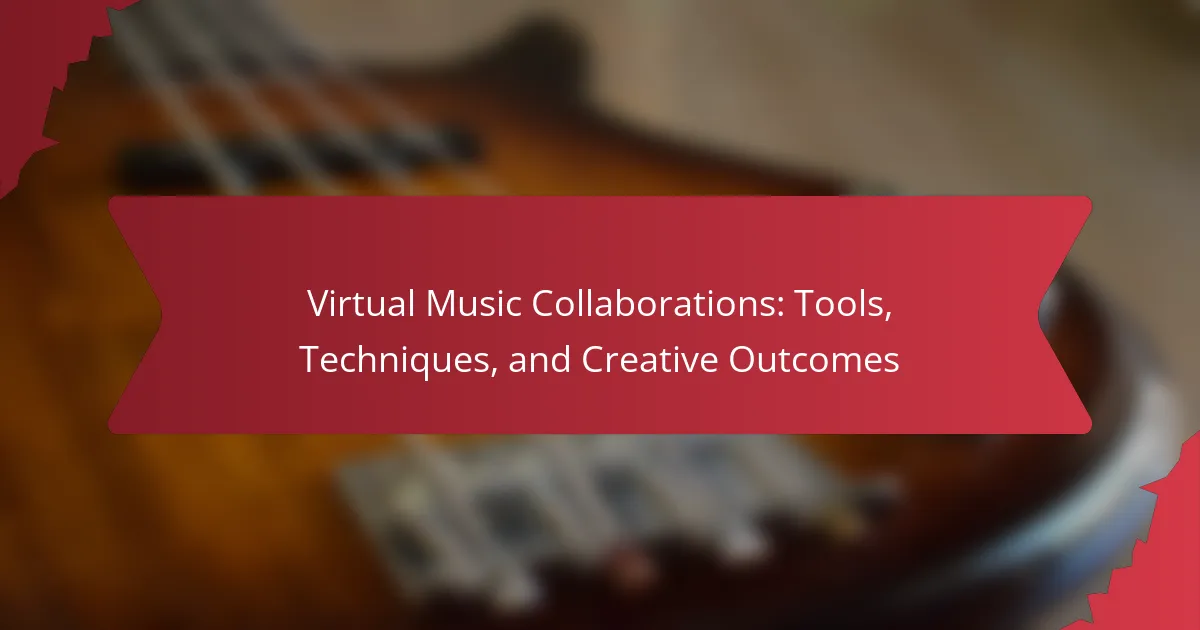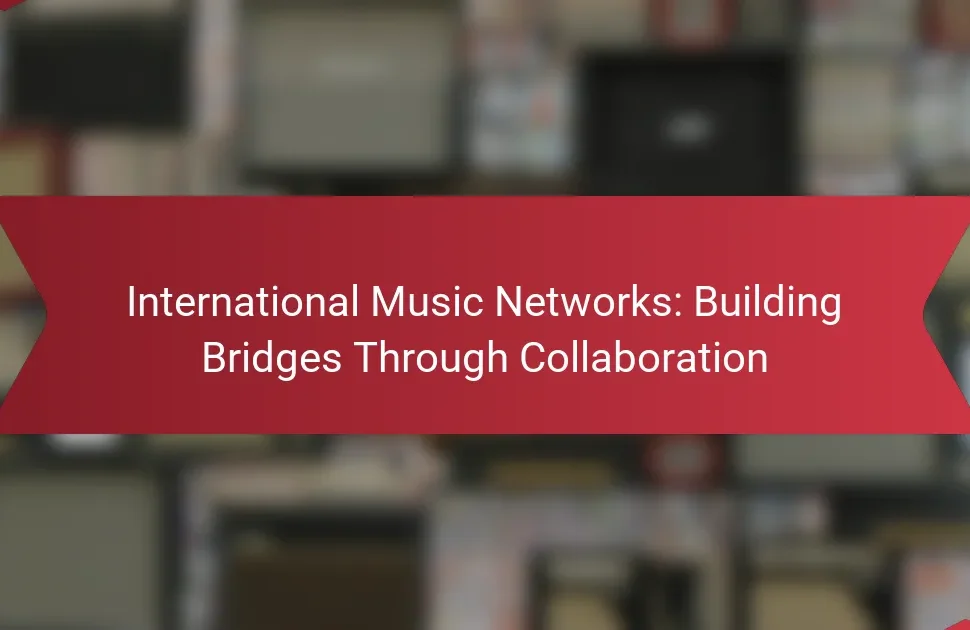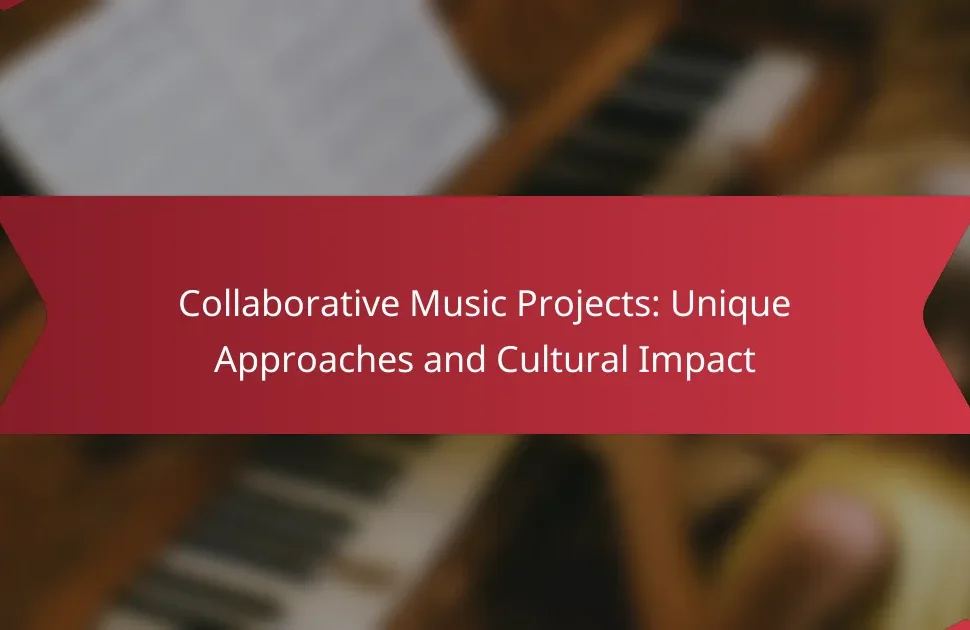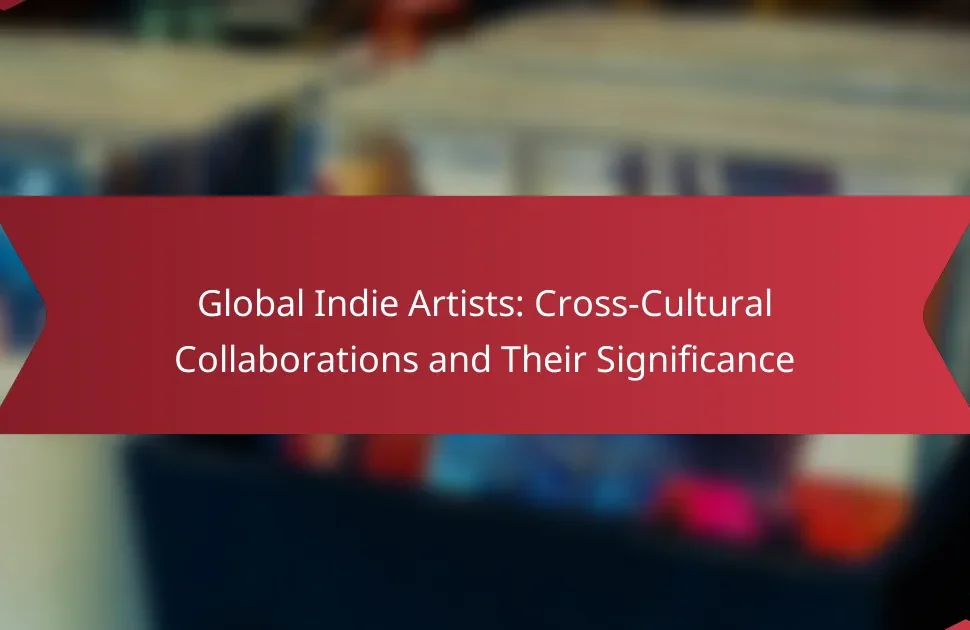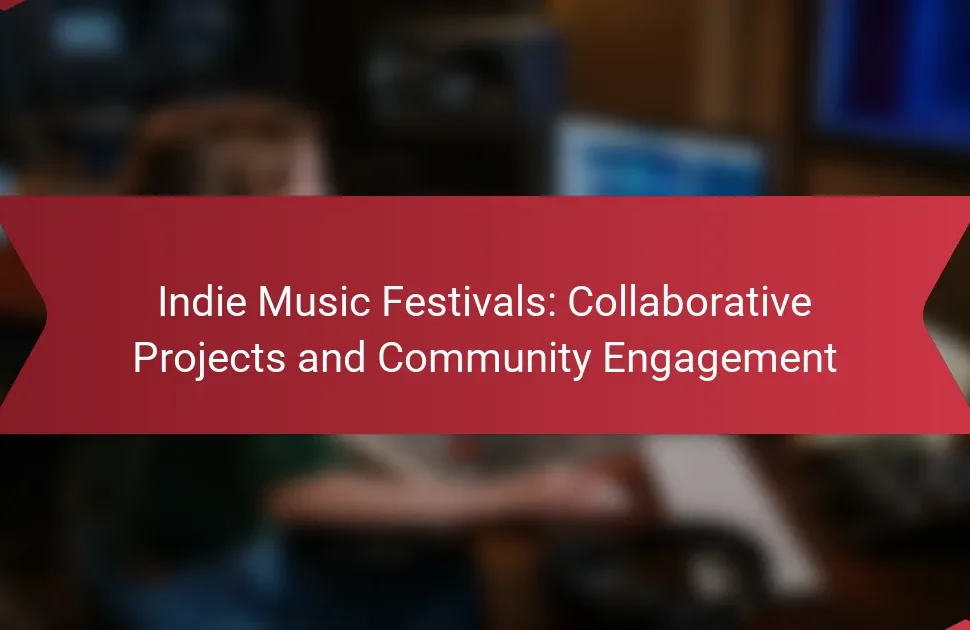Virtual music collaborations enhance creativity by connecting artists globally and allowing diverse contributions. This article explores essential tools like DAWs and cloud services, effective communication techniques, and the creative outcomes that emerge from these collaborations. Additionally, it addresses challenges such as technical issues and differing artistic visions, offering strategies to optimize virtual collaboration.
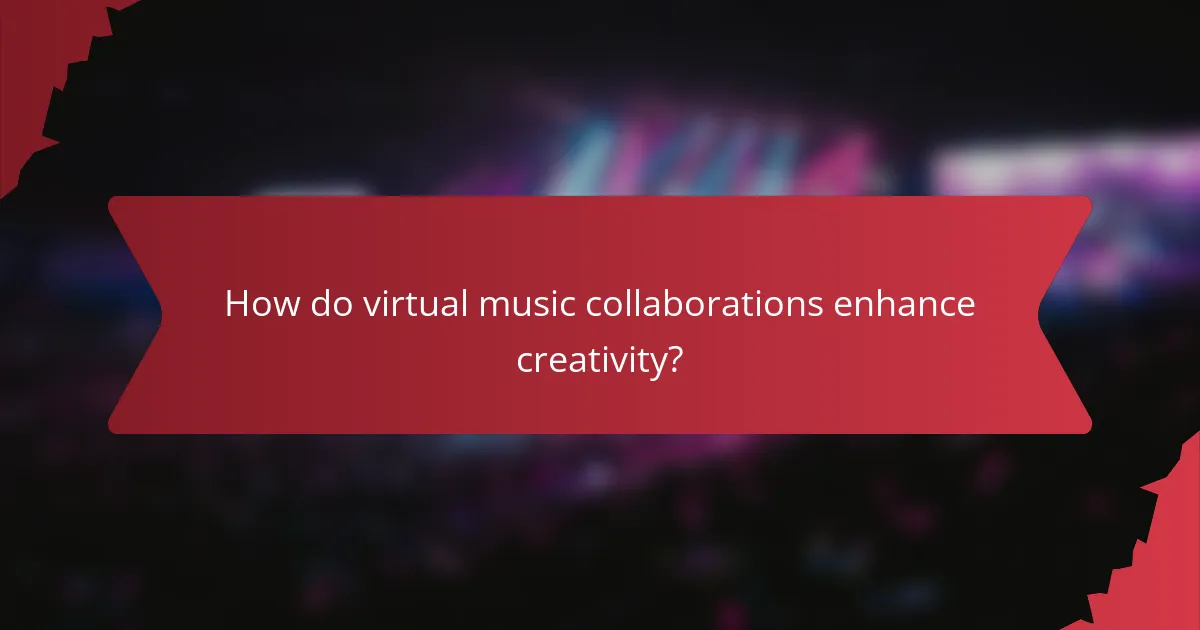
How do virtual music collaborations enhance creativity?
Virtual music collaborations enhance creativity by fostering diverse perspectives and innovative ideas. These collaborations utilize digital tools that allow musicians from different backgrounds to contribute unique styles and techniques. As a result, artists can experiment with new sounds and genres, leading to unexpected creative outcomes. The ability to connect globally expands artistic horizons and encourages cross-pollination of ideas, which can significantly elevate the creative process.
What are the psychological benefits of collaborating virtually?
Collaborating virtually in music fosters creativity, enhances social connections, and reduces stress. These psychological benefits stem from shared artistic expression and community building. Virtual platforms allow musicians to collaborate across distances, leading to increased motivation and innovation. Engaging with diverse perspectives can also boost emotional well-being and provide a sense of belonging.
How do diverse musical backgrounds influence collaboration outcomes?
Diverse musical backgrounds enhance collaboration outcomes by fostering creativity and innovation. Musicians from various genres bring unique perspectives, techniques, and influences that enrich the collaborative process. This diversity leads to a broader range of ideas and solutions, ultimately resulting in more innovative music. Collaborative tools, like digital audio workstations, facilitate these interactions, allowing seamless integration of different styles. As a result, virtual collaborations can produce unique soundscapes that reflect a fusion of cultural influences, enhancing the overall creative output.
What role does technology play in fostering creativity?
Technology significantly enhances creativity in virtual music collaborations by providing innovative tools and techniques. Digital audio workstations enable seamless remote collaboration, allowing artists to share and edit music in real-time. Cloud-based platforms foster diverse creative outcomes by connecting musicians worldwide, promoting unique sound combinations. Additionally, AI-driven software offers new compositional possibilities, inspiring artists to explore unconventional genres and styles. Overall, technology acts as a catalyst for creativity, expanding artistic horizons and enabling groundbreaking musical expressions.
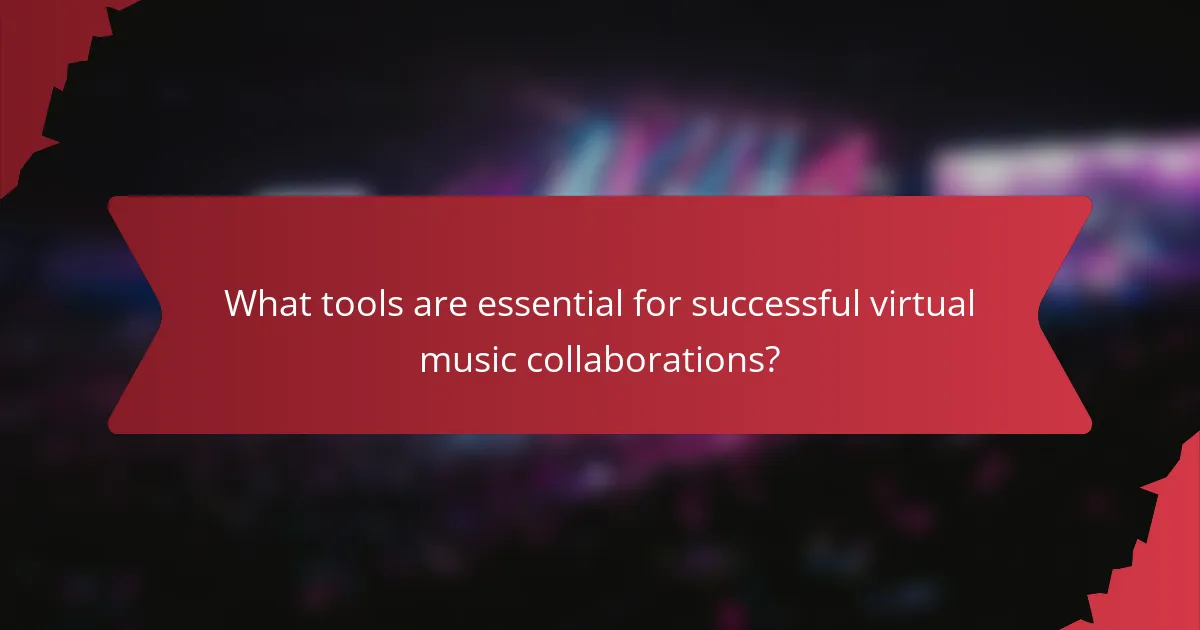
What tools are essential for successful virtual music collaborations?
Essential tools for successful virtual music collaborations include digital audio workstations (DAWs), cloud storage services, communication platforms, and collaboration software. DAWs like Ableton Live or Logic Pro enable music production and editing. Cloud services such as Google Drive or Dropbox facilitate file sharing and storage. Communication platforms like Zoom or Slack enhance team collaboration. Collaboration software like Splice allows real-time project sharing and editing. These tools streamline the creative process and improve workflow efficiency.
Which digital audio workstations (DAWs) are most popular among collaborators?
The most popular digital audio workstations (DAWs) among collaborators include Ableton Live, Logic Pro, FL Studio, Pro Tools, and Cubase. Each offers unique features that enhance virtual music collaboration.
Ableton Live excels in real-time performance and intuitive interface, making it a favorite for electronic music producers. Logic Pro provides extensive MIDI capabilities and a comprehensive library of sounds, appealing to songwriters and composers. FL Studio is known for its user-friendly workflow and powerful beat-making tools, attracting hip-hop and electronic artists. Pro Tools is the industry standard for professional studios, offering advanced editing and mixing capabilities. Cubase combines MIDI and audio features, suitable for diverse genres and production styles.
These DAWs facilitate seamless collaboration through cloud integration, shared projects, and versatile export options, enhancing creative outcomes.
What collaborative platforms facilitate real-time music creation?
Collaborative platforms that facilitate real-time music creation include tools like Soundtrap, BandLab, and Audiomack. These platforms enable musicians to work together seamlessly, regardless of location.
Soundtrap offers a cloud-based DAW with live collaboration features, allowing multiple users to create and edit tracks simultaneously. BandLab provides similar functionalities with additional social networking aspects, where users can share their projects and receive feedback. Audiomack focuses on music distribution and collaboration, enabling artists to co-create and promote their music in real-time.
These tools enhance the creative process, making it easier for artists to connect and produce music together.
How do file-sharing services impact collaboration efficiency?
File-sharing services significantly enhance collaboration efficiency in virtual music projects. They enable seamless access to shared files, allowing artists to work concurrently from different locations. This real-time collaboration accelerates the creative process and reduces delays. Additionally, tools like cloud storage facilitate easy version control, ensuring that all collaborators are on the same page. The ability to share large audio files without loss of quality further supports effective teamwork. Overall, these services streamline communication, improve workflow, and foster a more productive collaborative environment.
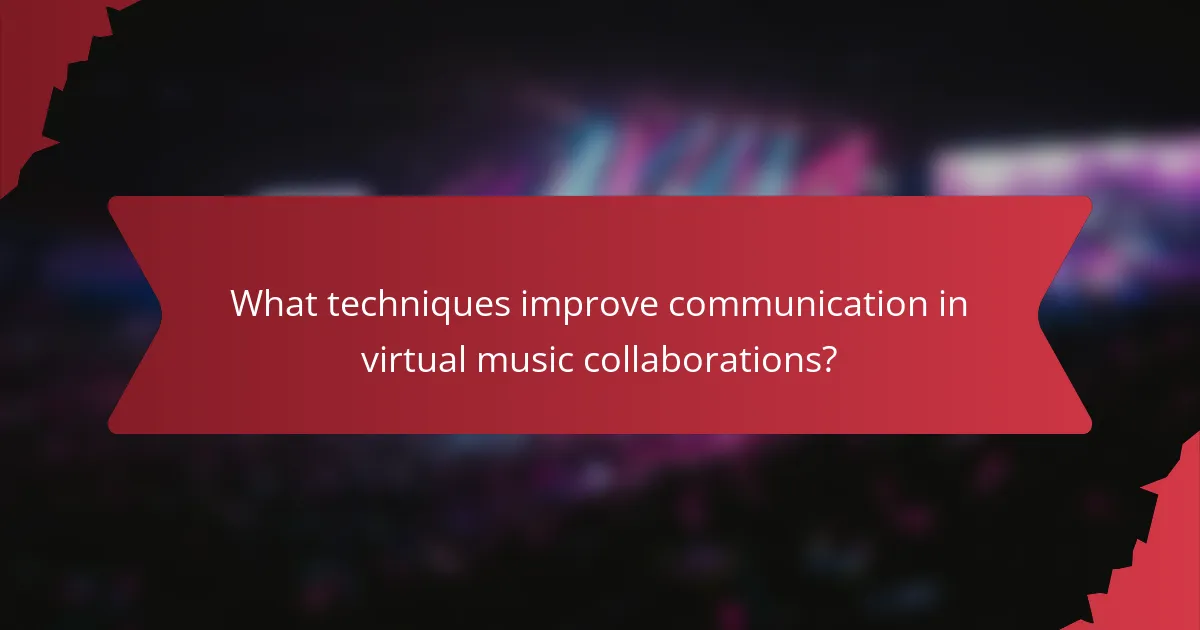
What techniques improve communication in virtual music collaborations?
Effective communication in virtual music collaborations can be enhanced through techniques like regular video meetings, clear project management tools, and collaborative platforms. These methods foster real-time feedback and creative synergy.
Utilizing video conferencing tools helps establish personal connections, ensuring that team members feel engaged. Project management applications streamline task assignments and deadlines, improving workflow efficiency. Collaborative platforms allow for shared access to files and resources, promoting transparency and collective creativity.
Incorporating these techniques can lead to higher-quality music productions and stronger team dynamics.
How can collaborators effectively manage time zones and schedules?
Collaborators can effectively manage time zones and schedules by utilizing scheduling tools and clear communication. Tools like World Time Buddy or Doodle help visualize time differences and find common availability. Establishing a shared calendar ensures everyone is on the same page regarding deadlines and meeting times. Regular check-ins can also help address any scheduling conflicts proactively.
What methods enhance feedback and critique during the collaboration process?
Utilizing structured feedback methods enhances collaboration in virtual music projects. Techniques such as regular check-ins, collaborative tools for real-time comments, and structured critique sessions foster effective communication.
1. Regular Check-ins: Schedule consistent meetings to discuss progress and gather input.
2. Collaborative Tools: Use platforms like Google Docs or Soundtrap for real-time feedback.
3. Structured Critique Sessions: Implement frameworks for giving and receiving feedback, focusing on specific attributes like melody or rhythm.
4. Surveys and Polls: Gather anonymous input on creative decisions to ensure everyone’s voice is heard.
These methods improve the quality of collaboration and creative outcomes in virtual music projects.
How does establishing clear roles contribute to collaboration success?
Establishing clear roles enhances collaboration success by ensuring accountability and streamlining communication. Defined responsibilities minimize overlap and confusion, allowing team members to focus on their strengths. This clarity fosters trust and encourages creative input, leading to innovative outcomes in virtual music collaborations. Furthermore, when roles are well-defined, project timelines improve, and productivity increases, ultimately benefiting the collective creative process.
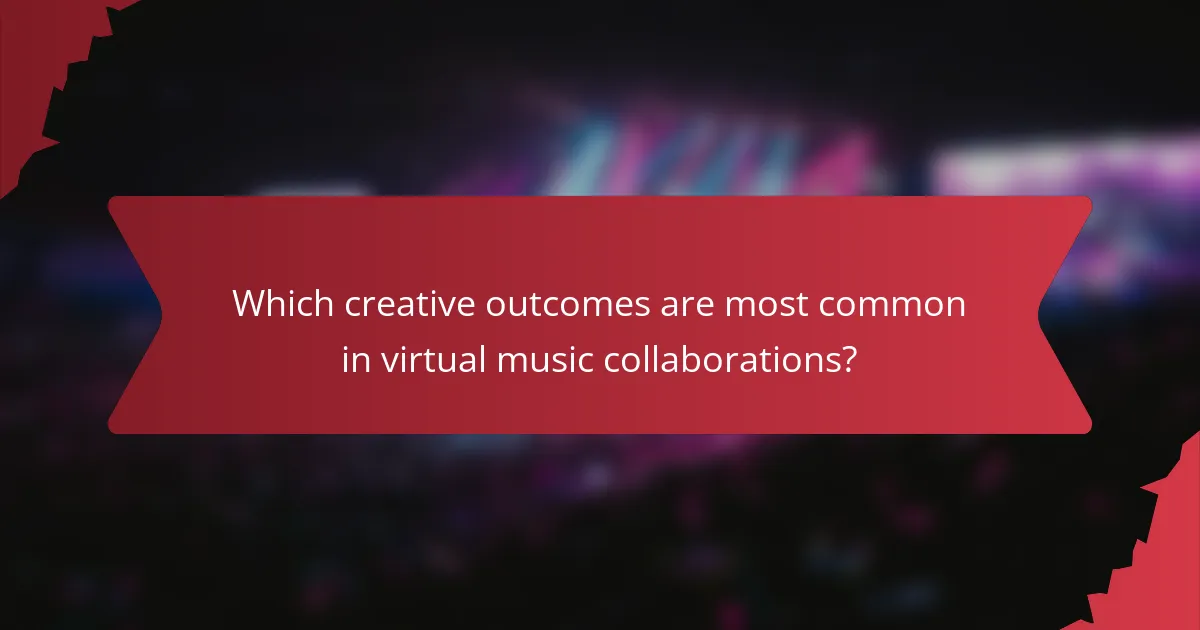
Which creative outcomes are most common in virtual music collaborations?
Virtual music collaborations often result in diverse creative outcomes, including unique tracks, innovative remixes, and collaborative albums. These outcomes leverage various tools and techniques, fostering creativity across genres. Additionally, many collaborations yield enhanced artistic expression through shared ideas and influences, leading to distinctive soundscapes. The integration of technology allows for seamless communication and collaboration, further enriching the creative process.
What genres benefit most from virtual collaborations?
Genres that benefit most from virtual collaborations include pop, hip-hop, electronic, and indie. These genres thrive on diverse contributions and technology-enhanced creativity.
Pop artists often collaborate with songwriters and producers worldwide, enhancing their sound. Hip-hop relies on producer-artist partnerships, allowing for innovative beats and lyrics. Electronic music benefits from remote collaborations, enabling artists to share samples and ideas seamlessly. Indie musicians leverage virtual tools to connect with other creatives, expanding their artistic reach.
These genres exemplify how virtual collaborations foster unique musical outcomes and broaden creative horizons.
How do virtual collaborations influence the music production process?
Virtual collaborations significantly enhance the music production process by fostering creativity and expanding access to diverse talents. These collaborations utilize digital tools that enable real-time communication and file sharing, allowing artists to work together regardless of location. This approach leads to innovative techniques and unique creative outcomes, as artists blend their distinct styles and influences. Additionally, virtual collaborations often reduce production time and costs, making music creation more accessible to emerging artists.
What are the unique sounds or styles that emerge from remote collaborations?
Unique sounds and styles from remote collaborations often arise from diverse cultural influences and innovative technology use. Artists leverage various digital tools to blend genres, creating unique sonic textures. For instance, remote collaborations can integrate instruments and styles from different regions, resulting in hybrid music forms. These collaborations also foster experimentation with production techniques, leading to distinctive soundscapes. The merging of individual creativity across geographic boundaries enhances originality, often producing music that reflects a fusion of artistic identities.
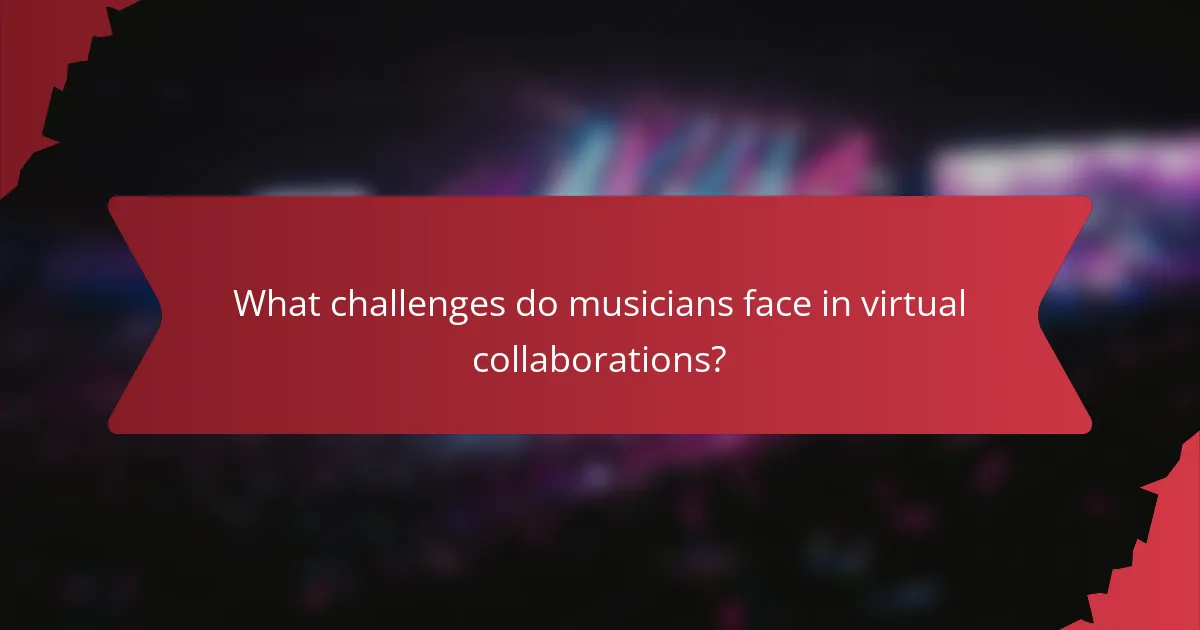
What challenges do musicians face in virtual collaborations?
Musicians face several challenges in virtual collaborations, including communication barriers, technical issues, and creative differences. Effective collaboration requires clear communication tools; however, misunderstandings can arise due to lack of non-verbal cues. Technical issues, such as latency and software compatibility, can hinder the creative process. Additionally, differing artistic visions can lead to conflict, complicating the collaboration. These challenges require musicians to be adaptable and resourceful to achieve successful outcomes in a virtual environment.
How do technical issues affect the collaboration experience?
Technical issues can significantly hinder the collaboration experience in virtual music projects. They can lead to delays, miscommunication, and frustration among collaborators. Common technical problems include poor internet connectivity, software incompatibility, and audio latency. These issues disrupt workflow and can affect the quality of the final creative outcomes. Ensuring reliable tools and infrastructure is crucial for a seamless collaboration experience.
What are common misunderstandings in virtual communication?
Common misunderstandings in virtual communication include misinterpretation of tone, over-reliance on text, and lack of non-verbal cues. These issues can lead to confusion and hinder collaboration. For example, humor may be perceived as sarcasm without vocal inflection. Additionally, technical difficulties can disrupt clarity, affecting the overall message. Understanding these factors can enhance virtual music collaborations.
How can cultural differences impact collaboration dynamics?
Cultural differences can significantly enhance or hinder collaboration dynamics in virtual music projects. Diverse perspectives foster creativity, but misunderstandings may arise due to varying communication styles.
Effective collaboration tools can bridge these gaps by facilitating clear dialogue. Techniques such as regular video check-ins and shared digital platforms promote understanding and cohesion.
Cultural awareness training can also improve team dynamics, ensuring members appreciate each other’s backgrounds and approaches. This leads to more innovative creative outcomes as diverse influences merge harmoniously.
Ultimately, embracing cultural differences can transform collaboration into a rich, multifaceted experience, yielding unique musical compositions that reflect a blend of global influences.
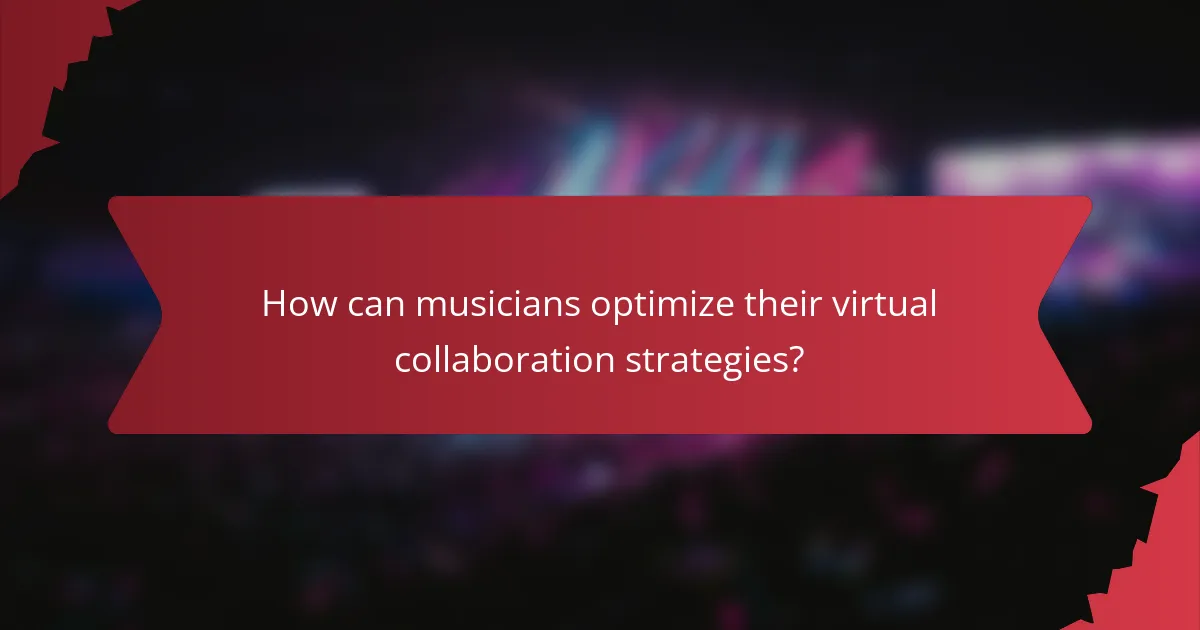
How can musicians optimize their virtual collaboration strategies?
Musicians can optimize their virtual collaboration strategies by leveraging effective tools and techniques. Utilizing platforms like Zoom, Ableton Live, and Splice enhances real-time communication and file sharing. Establishing clear goals and roles within the collaboration fosters productivity and creativity. Regular check-ins maintain alignment and address challenges promptly. Experimenting with different workflows encourages innovation and diverse creative outcomes.
What best practices should be followed for effective collaboration?
Effective collaboration in virtual music projects requires clear communication, the right tools, and structured workflows. Use platforms like Zoom or Discord for real-time discussions. Implement project management tools like Trello or Asana to track progress. Establish clear roles and responsibilities to streamline efforts. Regular check-ins enhance team cohesion and address any issues promptly.
How can musicians leverage social media to enhance their collaborations?
Musicians can enhance collaborations through social media by utilizing various platforms for networking, sharing ideas, and promoting their work. Effective use of tools like Instagram, Facebook, and TikTok allows musicians to connect with peers and audiences, fostering creativity and visibility.
Engagement is crucial; musicians should actively participate in discussions, comment on others’ work, and share behind-the-scenes content. This builds relationships and encourages collaborative projects. Hashtags related to music genres or collaboration can increase reach and attract potential partners.
Live streaming offers an interactive way to collaborate in real-time, allowing musicians to perform together despite physical distances. This unique attribute of social media enables spontaneous creativity and immediate feedback.
Finally, showcasing completed collaborations on social media can amplify exposure and attract further opportunities. By leveraging these techniques, musicians can significantly enhance their collaborative efforts and creative outcomes.
What common mistakes should be avoided in virtual music projects?
Avoiding common mistakes in virtual music projects enhances collaboration and creativity. Key pitfalls include poor communication, inadequate planning, neglecting feedback, and failing to utilize appropriate tools.
1. Poor communication: Clear communication is essential to align creative visions and expectations.
2. Inadequate planning: Establishing a structured timeline and clear roles prevents confusion and delays.
3. Neglecting feedback: Regularly seeking and incorporating feedback fosters improvement and collaboration.
4. Failing to utilize appropriate tools: Choosing the right software and platforms is crucial for seamless collaboration and workflow.
By addressing these mistakes, virtual music projects can achieve better outcomes and more effective teamwork.
